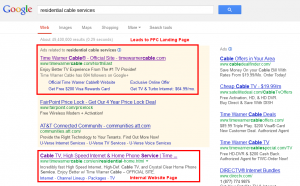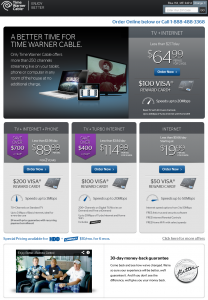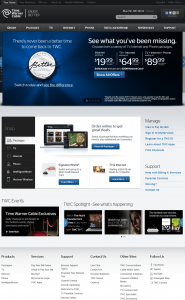A PPC landing page is where a user “lands” after clicking on a paid search advertisement. It can be any type of page including a homepage (gasp!), a product page, a lead capture page, or a specific jailed landing page used only for paid search traffic.

- Testing – Internet marketing requires consistent testing. You can test things like headline copy, calls to action, color changes, different images, page layout, etc. You can take what you learn while testing your PPC landing pages and apply those elements to your website to improve stickiness, CTR (click through rate), and ultimately conversions.
- Relevancy – Ideally, you should create a landing page for each ad group you are running. That way you can personalize the shopping experience. This will not only improve the user’s overall experience, it will aid in improving quality scores, which means paying less for your keywords. The more relevant your landing page is to the ad, the more likely it is the user will find what they need and take the action you want.
- Maintain Control – You can be selective with the elements you include (or choose not to include) on your PPC landing pages. Unlike a regular website where visitors can browse from page to page, you can remove the navigation from your landing page altogether. Using landing pages in this way allows you to maintain a controlled environment that is a safe testing ground for things like offering alternate pricing or presenting unique messaging.
- Reduce Options – By reducing options you can encourage users to take the singular action you want them to. On your website you have to cater to many types of audiences with different needs and in different stages of the buying process. But with PPC landing pages you can create targeted landing pages with a reduced amount of conversion options. See in the figures below; the PPC landing page presents 4 “order now” options, a telephone number to call, and a very small link to view more offers. On the interior website landing page there is a range of navigational options, social media icons, calls to action to present package offerings or to learn more about various products. There are also links on the page to navigate the user to account management or to contact support. By reducing the number of options on your PPC page you can limit the distractions so that the sole focus is on getting the user to convert.
- Conversion – Conversion is the MOST important element to keep in mind when creating landing pages. What do you want the user to do while on the page and how can you get them to do that? By taking the steps above you can create an effective, converting landing page. You want your landing page to be relevant to the searcher and present them the information they need. The page should have a limited number of ways to navigate away from it and a selective call to action that captures the user’s interest. Meanwhile, throughout this whole process, you are testing various elements and making iterative changes based on real visitor data to improve and streamline the conversion process.
The screen shot above is the search engine result page when I typed in “residential cable services.” You can see that Time Warner Cable had an ad as well as organic result – each page leading to a different landing page. The paid search ad’s landing page, as you can see below, has more clear options to convert with fewer opportunities to leave the page. I recently attended an Unbounce webinar with Oli Gardner who referred to links off the landing page as leaks. I really like that analogy because links on your PPC pages are exactly that, little ways people are leaking/leaving your page.
Review the two landing page examples below – you can see how the PPC landing page was relevant to my particular search query, how they maintain control by having limited options, and how clearly they are making the calls to action. I am sure they are testing many different layouts, imagery, and types of copy and are increasing their conversion rate with their landing pages.
Jenika
Latest posts by Jenika (see all)
- Selecting the Right Keywords for Your Business, SEO Tips from Bubba - April 24, 2015
- P1WS Celebrates Haiku Poetry Day - April 17, 2015
- Our Favorite Internet Web Browsers and Extensions - April 15, 2015


Leave a Comment